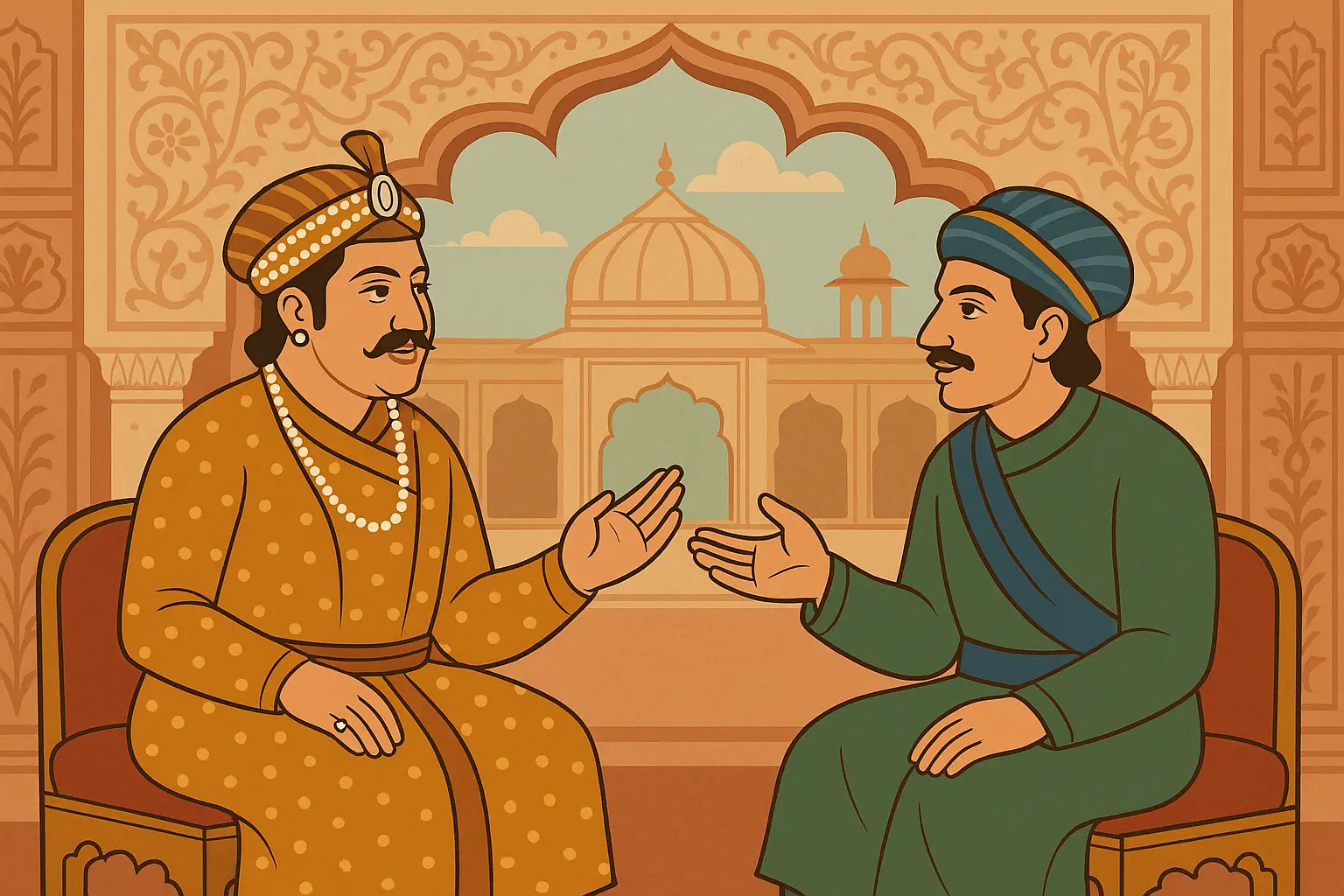Last year, I was stuck in this frustrating situation at work. You know that colleague who somehow always ends up with credit for everyone else’s ideas? Yeah, we all have one. I was complaining to my mom about it (as you do), and she told me this old story about Birbal that her grandmother used to tell. Honestly, I thought it was just going to be another “listen to your elders” moment, but it actually worked.
These stories from Emperor Akbar’s court aren’t just entertaining tales – they’re basically a masterclass in handling difficult people and impossible situations. I’ve been collecting the best ones, and I’m not gonna lie, they’ve changed how I deal with everything from workplace drama to family arguments.
According to recent analysis, Birbal stories continue to offer practical wisdom for modern decision-making, with their lessons being “remarkably pragmatic” despite their historical setting. I discovered this myself when facing that workplace conflict. Instead of confronting my credit-stealing colleague directly (which felt too aggressive and probably would’ve backfired), I used Birbal’s approach from “The Jealous Courtiers” story. I created a situation where their behavior became obvious to everyone naturally, without me having to point fingers. Took about three months and got pretty awkward at first, but it worked.
Whether you’re dealing with difficult people, trying to solve problems that seem impossible, or just want to communicate better, these stories offer fresh ways to think about old challenges. Plus, they’re actually fun to read.

What Makes These Stories Worth Your Time
Look, there are hundreds of Birbal stories out there, and honestly? A lot of them are pretty forgettable. But the good ones – the ones that actually stick with you and change how you think – they all have a few things in common.
Stories That Actually Work in Real Life
The best Birbal stories don’t just sound clever – they give you something you can actually use. They show you how to handle jealous coworkers, deal with unreasonable demands, or figure out what people really mean when they’re not saying it directly.
I’ve learned to look for stories that tackle stuff we all deal with: pride, jealousy, miscommunication, unfair treatment. These themes show up everywhere, whether you’re in a corporate office or dealing with family drama.
They Don’t Talk Down to You
What I love about these stories is that Birbal doesn’t lecture anyone. He just creates situations where people figure things out for themselves. It’s way more effective than being told what to do, and it doesn’t make anyone feel stupid.
The stories work because they show rather than tell. Instead of saying “don’t be jealous,” they show what jealousy looks like and how it backfires. Instead of explaining why assumptions are dangerous, they demonstrate it through characters making obvious mistakes.
You Remember Them
Here’s the thing about good stories – they stick in your head. I can still remember the details of stories my mom told me years ago, but I can’t recall a single PowerPoint slide from last month’s training session.
These stories work because they’re memorable. When you’re facing a similar situation, you think “Oh wait, this is like that Birbal story where…” and suddenly you have a framework for handling it.
Here’s what to look for in a good Birbal story:
-
Clear problem that feels familiar
-
Characters you can relate to (even the difficult ones)
-
Solution that surprises you but makes perfect sense
-
Lesson you can actually use in your own life
-
Details that stick in your memory
They’re Not Trying to Be Perfect
The best stories admit that life is messy. People have mixed motives, situations are complicated, and sometimes there isn’t a perfect solution – just a better way to handle things.
Birbal doesn’t always make everyone happy. Sometimes his solutions work because they’re fair, not because they’re pleasant. That’s way more realistic than stories where everyone learns their lesson and lives happily ever after.
For readers seeking more examples of masterful storytelling techniques, our guide to folktale story examples demonstrates similar narrative principles across different cultural traditions.

25 Stories That Actually Matter
I’ve organized these into six categories based on the types of problems they help with. Some are about fairness and wisdom, others about creative problem-solving or dealing with difficult people. They range from simple “aha moment” stories to more complex explorations of human psychology.
What Do These Stories Teach About Being Fair? (1-5)
1. The Most Beautiful Child
Akbar basically dares Birbal to find the most beautiful kid in the whole kingdom. So what does Birbal do? He brings his own son. Akbar’s like “Really?” And Birbal’s like “Of course – every parent thinks their kid is the most beautiful.” Boom. Mind blown.
This story hit me hard when I realized I was doing the same thing at work – always thinking my ideas were the best ones, my team’s work was superior, my approach was obviously correct. It’s basically why you can’t see what’s wrong with your own writing until someone else reads it.
The lesson? Your personal attachment to something changes how you see it. This applies to everything from hiring decisions (do you favor candidates who remind you of yourself?) to evaluating ideas in meetings.
My friend Sarah runs a marketing team, and she kept picking ideas from people she used to work with. After reading this story, she realized she was basically doing the “beautiful child” thing – everything looked better when it came from people she already liked. Now she tries to evaluate campaigns without knowing who created them first.
2. The Pot of Wit
A scholar shows up claiming he’s got all this wisdom stored in a magical pot. Birbal’s response? “Cool, show me.” The guy can’t actually demonstrate any of this supposed wisdom, and his whole act falls apart.
I use this one all the time now. When someone makes big claims about their expertise, I ask for examples. When a consultant promises amazing results, I want to see their previous work. When anyone says they have the answer to everything, I get suspicious.
It’s the difference between talking a good game and actually playing one. And honestly? Most of the time, people who really know their stuff don’t need to brag about it.
3. The True Worshipper
Akbar tells everyone that God is going to appear in the courtyard, and all the courtiers rush out to see. Except Birbal. When Akbar asks why, Birbal says if God really showed up, people would be too awestruck to casually stroll out and gawk.
This one’s about the difference between doing something because you really believe in it versus doing it because everyone else is. It’s like the difference between people who actually care about a cause and people who just post about it on social media.
I think about this story whenever there’s some trending topic at work that everyone’s suddenly passionate about, or when I catch myself agreeing with something just because it’s popular.
4. The Farmer’s Well
Here’s a sneaky one. A farmer sells his well to a neighbor but then claims the buyer can’t use the water because he only sold the well, not the water inside it. Birbal’s solution? If the water belongs to the farmer, he needs to pay rent for storing it in someone else’s well.
The farmer’s trying to have it both ways, and Birbal uses his own logic against him. It’s brilliant because it forces the guy to either admit he was being dishonest or pay up.
I’ve used this approach when people try to manipulate situations with clever wordplay. Take them at their word and follow their logic all the way through – usually they’ll back down when they see where it leads.
5. The Equal Inheritance
A merchant has two sons – one smart, one not so much – and doesn’t know how to divide his wealth fairly. Birbal suggests giving them equal value but in different forms: gold coins to the smart son, copper coins to the not-so-smart one. The copper pile looks bigger, so both sons feel they got a good deal.
This isn’t about tricking anyone – it’s about understanding that people perceive value differently. The smart son knows gold is worth more per coin, the other son is happy because his pile looks bigger. Everyone wins.
I think about this whenever I’m negotiating anything. Sometimes it’s not about splitting things exactly down the middle – it’s about finding what each person actually values.
How Do You Solve Impossible Problems? (6-10)
6. Counting the Crows
Akbar asks Birbal to count all the crows in the kingdom. Impossible, right? Birbal confidently says there are exactly 50,000 crows. When Akbar questions this, Birbal says if there are more, they’re visitors from other kingdoms; if there are fewer, some local crows are traveling.
This is my go-to story for handling unrealistic deadlines or impossible requests from bosses. You give a confident answer that sounds specific but has built-in flexibility. “This project will take six weeks, but if we get additional requirements, we’ll need extra time for proper implementation.”
It’s not about being dishonest – it’s about managing expectations while acknowledging that some variables are outside your control.

7. The Blind Men and the Elephant
You probably know this one. Blind men touch different parts of an elephant and argue about what it is – snake, wall, tree trunk. Each person’s experience is real, but none of them has the complete picture.
This story comes up constantly in my work life. Marketing sees one side of a problem, engineering sees another, sales has their perspective. Everyone’s right based on their experience, but nobody has the full picture.
Now when people are arguing about something, I try to figure out what part of the “elephant” each person is touching instead of assuming someone’s wrong.
8. The Magic Donkey
A merchant claims his donkey can carry unlimited weight. Birbal’s response? Start loading it up until it collapses. Problem solved.
This is about testing extraordinary claims instead of just accepting them. Whether someone’s promising amazing investment returns, claiming they can deliver impossible results, or insisting their new system will solve everything – ask for proof.
I learned this the hard way with a contractor who promised our kitchen renovation would take “two weeks, max.” Should’ve asked to see their previous projects and timelines.
9. The Singing Donkey
Villagers complain about a donkey that won’t stop braying. Instead of trying to silence it, Birbal suggests having it “perform” during the day for coins. Same noise, but now it’s profitable entertainment instead of a nuisance.
This one’s about reframing problems as opportunities. That customer who always complains? They’re giving you valuable feedback. That team member who asks too many questions? They’re helping you identify gaps in your communication.
It doesn’t work for everything, but sometimes the thing that’s driving you crazy is actually useful if you look at it differently.
10. The Three Questions
A philosopher asks Birbal three impossible questions designed to stump him. Instead of trying to answer them, Birbal points out that the questions themselves don’t make sense.
Sometimes the smartest response isn’t trying to solve an impossible problem – it’s questioning whether the problem is real in the first place.
I use this when people ask me to do things that seem off. Instead of struggling with a bad brief or unclear request, I ask whether we’re solving the right problem. Usually we’re not.
What Makes People Tick? (11-15)
These psychological insights align with the character development techniques explored in our comprehensive guide to story examples that transform understanding, showing how effective narratives reveal human nature through memorable scenarios.
11. The Jealous Courtiers
Other courtiers get jealous of Birbal’s relationship with Akbar and try to undermine him. Instead of defending himself directly, Birbal creates situations where their jealousy becomes obvious to everyone.
This is the story that helped me with my credit-stealing coworker. Instead of confronting him (which would’ve made me look petty), I started documenting everything publicly. Shared project updates, copied stakeholders on emails, made contributions visible. His pattern became obvious without me having to say anything.
It took patience, and there were some awkward moments, but it worked. The key is letting people’s behavior speak for itself instead of trying to convince others what’s happening.
12. The Proud Pundit
A scholar arrives claiming he knows more than Birbal. Instead of debating theory, Birbal asks practical questions that reveal the guy has no real-world experience.
This happens all the time – people with impressive credentials who can’t actually do the work. The MBA who’s never managed anyone, the consultant who’s never worked in your industry, the expert who sounds great in meetings but can’t deliver results.
I’ve learned to ask for specific examples and practical applications. Theory is fine, but show me what you’ve actually done.
13. The Generous Miser
A stingy guy wants to throw a feast to look generous without actually spending money. Birbal helps him create an impressive-looking event with fancy decorations but very little actual food.
This is about the difference between appearing generous and actually being generous. You see this everywhere – companies that talk about caring for employees but don’t offer decent benefits, people who make a big show of charity but give very little.
It’s a reminder to look at actions, not just words or appearances.
14. The Truthful Liar
A guy known for lying claims he always tells the truth. Birbal asks him to make a statement that proves both his reputation and his claim. The guy can’t do it without contradicting himself.
This is about people who can’t keep their story straight. They want to be seen as honest while continuing to deceive people. Eventually, the contradictions catch up with them.
I think about this when someone’s explanation keeps changing, or when their words don’t match their actions over time.
15. The Wise Fool
A court jester challenges Birbal through seemingly foolish behavior that actually contains deep insights. Birbal recognizes the wisdom hidden in the apparent foolishness.
This one reminds me to stay open to learning from unexpected sources. Sometimes the person who seems least qualified has the most valuable perspective. The new hire who asks “dumb” questions that reveal problems everyone else has gotten used to. The customer service rep who understands user needs better than the product team.
Wisdom doesn’t always come in the package you expect.

How Do You Lead Without Being a Jerk? (16-20)
16. The Heavy Punishment
Akbar wants to severely punish someone for a minor offense to “set an example.” Birbal shows him how excessive punishment actually undermines authority rather than strengthening it.
This is huge for anyone who manages people. When someone screws up, your first instinct might be to come down hard to show you’re serious. But if the punishment doesn’t fit the crime, people lose respect for your judgment.
I learned this as a team lead when I overreacted to someone missing a deadline. The punishment was way worse than the mistake, and it hurt team morale more than the original problem did.
17. The Royal Test
Akbar pretends to consider a terrible decision to test his advisors’ loyalty. Everyone agrees except Birbal, who respectfully disagrees. Turns out, that’s what real loyalty looks like.
This one’s scary because disagreeing with your boss feels risky. But Birbal frames it as protecting Akbar’s interests, not opposing his authority.
I’ve tried this approach when I thought my manager was making a mistake. Instead of saying “that’s wrong,” I said “I’m worried this might hurt our goals because…” It’s terrifying the first few times, but good managers appreciate honest feedback.
18. The Democratic Decision
Villagers can’t agree on a community issue. Instead of just going with majority rule, Birbal finds a solution that addresses everyone’s core concerns.
This is advanced stuff – finding solutions that work for everyone instead of just picking sides. It takes longer and requires more creativity, but the buy-in is so much better.
I used this approach when our team was split on which direction to take a project. Instead of voting, we spent time understanding what each side really needed, then found a third option that satisfied both concerns.
Here’s what I’ve learned about leadership from these stories:
-
Excessive punishment backfires
-
Real loyalty sometimes means disagreement
-
The best solutions address everyone’s concerns
-
Authority comes from serving others’ interests
19. The Corrupt Official
An official is taking bribes but hiding it cleverly. Instead of accusing him directly, Birbal creates a situation that forces the guy to reveal his corruption himself.
This is tricky because you can’t always prove when someone’s being dishonest. But you can create circumstances where their true behavior becomes obvious. It’s like setting up a situation where someone has to choose between doing the right thing and protecting their scheme.
I’ve seen this work in organizations where someone was clearly cutting corners or taking credit unfairly. Instead of making accusations, create transparency around processes and results. The problems usually reveal themselves.
20. The Fair Tax
People complain that taxation is unfair. Birbal creates a system where everyone contributes based on what they can afford while getting proportional benefits.
This isn’t just about taxes – it’s about any situation where you need to allocate resources fairly. The key insight is that “fair” doesn’t always mean “equal.” Sometimes fair means considering people’s different circumstances and capabilities.
I think about this when dividing work on team projects or deciding how to split expenses with friends. What matters is that everyone feels the arrangement is reasonable given their situation.

How Do You Actually Communicate with People? (21-23)
21. The Silent Message
Akbar sends Birbal a blank piece of paper. Birbal responds with an empty box. Both understand the message perfectly because they share the same framework for interpretation.
This is about how communication requires shared understanding. You can’t just assume people know what you mean – you need common ground for your message to work.
I learned this the hard way when I sent what I thought was a clear email to a client, but they interpreted it completely differently. Now I try to confirm that we’re on the same page before assuming my message got across.
22. The Diplomatic Insult
A foreign ambassador subtly insults Akbar. Birbal responds in an equally indirect way that points out the rudeness while maintaining diplomatic courtesy.
Sometimes you need to address inappropriate behavior without escalating the situation. This is especially useful in professional settings where you can’t just tell someone they’re being a jerk.
The key is matching their approach while making your point clear. If they’re being passive-aggressive, you can be passive-aggressive back in a way that exposes their behavior.
23. The Marriage Counselor
A couple argues constantly about who’s right. Instead of taking sides, Birbal helps them understand each other’s perspectives and find shared goals.
This works for any relationship conflict, not just marriage. When people are fighting, they usually stop listening to each other and just focus on proving they’re right.
The breakthrough comes when you help them see the situation from the other person’s point of view. Once they understand why the other person feels that way, they can work together instead of against each other.
When tensions arose between our sales and development teams over feature priorities, I used this approach. Instead of choosing sides, I had each team explain their constraints and goals to the other. Sales learned about technical debt, development understood customer urgency. This led to a collaborative solution that worked for both teams.
How Do You Get Creative When You’re Stuck? (24-25)
The creative problem-solving demonstrated in these final stories connects to the broader principles discussed in our exploration of story theme examples, showing how innovation emerges from reframing familiar challenges.
24. The Impossible Garden
Akbar challenges Birbal to create a garden that blooms in winter. Birbal creates an indoor garden with artificial flowers so beautiful they look real.
This is about creative interpretation of impossible requests. Instead of saying “can’t be done,” Birbal focused on what Akbar actually wanted – beautiful winter blooms – and found an unexpected way to deliver it.
I use this thinking when clients ask for things that seem impossible within their budget or timeline. Instead of just saying no, I try to understand what they really need and find alternative ways to give them that result.
25. The Time Machine
Someone claims to have traveled from the future. Instead of dismissing them immediately, Birbal asks systematic questions that reveal inconsistencies in their story.
This is about healthy skepticism. Don’t just accept extraordinary claims, but don’t dismiss them without investigation either. Ask questions that would reveal the truth either way.
I think about this whenever someone presents a “revolutionary” solution or makes promises that sound too good to be true. Most of the time, a few practical questions reveal the problems.

Why These Stories Actually Work
Understanding what makes each category effective helps you get more out of these stories. It’s not just about memorizing clever solutions – it’s about recognizing the patterns and principles you can apply to your own situations.
The Foundation Stories Build Your Thinking
The wisdom and justice stories work because they address questions everyone faces. What’s really fair? How do we handle bias? What does authentic behavior look like?
“The Most Beautiful Child” sticks with you because it reveals something true about human nature that you recognize in yourself. Once you see how personal attachment affects judgment, you can’t unsee it.
These stories don’t lecture you about being objective – they show you what subjective thinking looks like in action. That’s way more effective than being told to “check your bias.”
The Problem-Solving Stories Give You Mental Tools
“Counting the Crows” works because it demonstrates a specific technique: confident flexibility. You can apply this approach to project estimates, deadline negotiations, and resource planning.
“The Blind Men and the Elephant” provides a complete framework for understanding why people disagree. It shows how limited information creates confident conclusions, teaches the value of multiple viewpoints, and demonstrates how to integrate different perspectives.
These aren’t just entertaining puzzles – they’re mental models you can use when facing similar challenges.
The Psychology Stories Help You Read People
The human nature stories excel at revealing hidden motivations. “The Jealous Courtiers” shows how envy makes people act against their own interests. “The Proud Pundit” exposes the gap between credentials and actual capability.
These insights feel timeless because they address fundamental patterns in human behavior. Jealousy, pride, and self-deception show up everywhere, regardless of culture or time period.
They work as diagnostic tools for understanding difficult people and predicting behavior based on underlying motivations.

The Leadership Stories Address Real Tensions
The leadership stories tackle the hardest challenges – balancing authority with fairness, handling loyalty versus honesty, managing individual needs with group requirements.
“The Royal Test” shows that true loyalty sometimes requires disagreement. This is a lesson many leaders struggle with because it feels counterintuitive.
“The Democratic Decision” demonstrates consensus-building that goes beyond simple voting. This teaches political skills that work in any group situation.
These stories work because they address real dilemmas leaders face. The principles apply whether you’re managing a team, raising kids, or organizing a community group.
The Communication Stories Build Bridges
The relationship stories teach that effective communication requires shared understanding and mutual respect. “The Silent Message” shows how communication depends on common frameworks.
“The Marriage Counselor” demonstrates mediation skills that prioritize understanding over winning. This creates lasting solutions instead of temporary truces.
These principles work across different contexts – workplace conflicts, family arguments, community disputes. The techniques remain relevant despite changing technology and culture.
The Innovation Stories Push Boundaries
The creativity stories demonstrate the highest level of problem-solving – handling impossible challenges through redefinition. “The Impossible Garden” shows how focusing on desired outcomes rather than conventional methods opens new possibilities.
These stories model the creative process: identify constraints, question assumptions, find alternative approaches. They teach innovation as a learnable skill rather than mysterious inspiration.
The principles apply to business challenges, artistic projects, and personal problem-solving. They provide frameworks for approaching situations that seem impossible within normal thinking.

How This Stuff Actually Helps in Real Life
These ancient stories offer practical approaches for modern problems. From handling difficult colleagues to making better decisions under pressure, Birbal’s methods translate directly to stuff we deal with every day.
The practical wisdom demonstrated in these tales shares common ground with the storytelling techniques explored in our guide to short story examples, where memorable characters face relatable challenges with unexpected solutions.
At Work (Where Most of Us Spend Too Much Time)
When someone takes credit for your work, “The Jealous Courtiers” gives you a game plan. Instead of confronting them directly (which often backfires), create situations where their behavior becomes obvious naturally. Document your contributions, share progress updates widely, let their pattern reveal itself.
“The Royal Test” is perfect for giving feedback to difficult bosses. Frame disagreement as protecting their interests rather than opposing their authority. Present alternatives as additional information, not criticism.
For impossible deadlines, “Counting the Crows” is your friend. Give confident estimates with built-in flexibility. “This project needs six weeks, but if we get additional requirements, we’ll need extra time for proper implementation.”
In Relationships (The Really Important Stuff)
“The Marriage Counselor” approach works for any conflict. Instead of taking sides or deciding who’s right, help both people understand each other’s perspectives and identify shared goals. This creates resolution through understanding, not victory.
“The Most Beautiful Child” reminds you to watch out for bias when making decisions about people you care about. When you’re emotionally invested in someone, acknowledge that bias and get outside perspectives.
The communication lessons from “The Silent Message” apply to understanding what people don’t say. Pay attention to omissions, hesitations, and non-verbal cues that reveal underlying concerns.
When Making Decisions (Especially the Hard Ones)
“The Three Questions” teaches you to challenge problem definitions before attempting solutions. When facing impossible demands, examine whether the question itself makes sense.
“The Magic Donkey” shows the importance of testing claims before accepting them. Whether it’s investment opportunities, job offers, or major purchases, insist on practical demonstration rather than just persuasive presentations.
For creative challenges, “The Impossible Garden” demonstrates redefining success parameters to open new possibilities. Focus on desired outcomes rather than conventional methods.
Here’s what works in daily life:
-
Credit-stealing colleague → Document contributions publicly (The Jealous Courtiers)
-
Unrealistic deadlines → Confident estimates with built-in explanations (Counting the Crows)
-
Relationship conflicts → Focus on shared goals, not who’s right (The Marriage Counselor)
-
Extraordinary claims → Demand practical demonstrations (The Magic Donkey)
-
Impossible requests → Question whether the problem is real (The Three Questions)
Dealing with Difficult People (We All Have Them)
“The Truthful Liar” helps with people who contradict themselves. Instead of pointing out inconsistencies directly, ask questions that force them to confront their own contradictions.
“The Proud Pundit” works for know-it-alls. Ask practical questions that reveal the gap between theoretical knowledge and real-world application. This exposes limitations without direct confrontation.
For manipulative behavior, “The Farmer’s Well” shows how to use someone’s logic against them. When people try to deceive you, apply their reasoning consistently to reveal its flaws.
Building Influence (Without Being Manipulative)
“The Pot of Wit” demonstrates the importance of showing competence rather than claiming it. Let your results speak for themselves instead of making grand statements about your abilities.
“The Wise Fool” reminds you to stay open to learning from unexpected sources. Wisdom can come from anyone, regardless of their apparent status or presentation.
The leadership stories teach that real authority comes from serving others’ interests rather than demanding compliance. Focus on helping people achieve their goals instead of asserting your position.

Using These Stories to Improve Your Own Communication
The storytelling principles in Birbal tales can help you communicate more effectively, whether you’re writing, presenting, or just trying to get your point across in everyday conversations.
For writers looking to master the art of concise yet impactful storytelling, our comprehensive guide on how to write flash fiction demonstrates similar principles of maximum impact with minimum words, just like these timeless stories.
These tales show how effective storytelling packs maximum impact into minimal space, teaching profound lessons through engaging narratives that stick with people.
Start with Something That Hooks People
Birbal stories immediately grab your attention with intriguing setups. “Akbar asks Birbal to find the most beautiful child in the kingdom.” Right away, you’re curious about how this is going to play out.
Whether you’re writing an email, giving a presentation, or telling a story at dinner, lead with something that makes people want to know what happens next.
Make It About Real Human Stuff
The genius of these stories is they deal with universal experiences – jealousy, pride, miscommunication, unfair treatment. Even though they’re set in a royal court from centuries ago, the human dynamics feel familiar.
When you’re trying to make a point, connect it to experiences your audience recognizes. Don’t just explain concepts – show how they play out in situations people can relate to.
Show, Don’t Lecture
Birbal never tells people what to think. He creates situations where they figure things out for themselves. This is way more effective than being preachy or condescending.
Instead of saying “you should be more objective,” tell the story of “The Most Beautiful Child” and let people draw their own conclusions. Instead of explaining why assumptions are dangerous, show what happens when the blind men touch different parts of the elephant.
Keep It Simple but Layered
These stories work on multiple levels – surface entertainment with deeper wisdom underneath. You can enjoy them as simple tales while also extracting practical insights for real-world application.
This is the sweet spot for any communication: accessible enough for everyone to follow, rich enough to reward careful attention.
Make It Memorable
Good stories stick in your head. When you face a similar situation later, you think “Oh, this is like that story where…” and suddenly you have a framework for handling it.
Use specific details, relatable characters, and surprising-but-logical solutions. These elements help people remember not just the story, but the lesson it contains.
The storytelling craft demonstrated in these ancient tales offers timeless principles for modern communication. Whether you’re creating content for business, education, or personal expression, these techniques can help you craft messages that resonate with audiences while delivering meaningful insights.
Ready to improve your own storytelling? Try Nairrate’s AI story generation tools and discover how modern technology can help you craft narratives with the same timeless appeal and practical wisdom that has made Birbal stories beloved across cultures and generations.

Look, Here’s What I’ve Learned
These 25 Birbal stories aren’t going to solve all your problems. Let’s be honest – life is messier than any story, and sometimes there isn’t a clever solution that makes everyone happy.
But they’ve changed how I think about stuff I deal with every day. The “counting crows” approach has saved me countless times when my boss asks for impossible deadlines. The jealous courtiers story was a game-changer for office politics. The marriage counselor technique actually works for family arguments (though it takes practice and patience).
What makes these stories valuable isn’t their complexity – it’s their simplicity. They’re just good common sense wrapped up in memorable scenarios that stick in your head. And honestly, that’s exactly what we need more of.
Yes, I realize I’m getting life advice from stories about a guy who lived 400 years ago. But hey, if it works, it works. Human nature hasn’t changed that much, and the problems we face – jealousy, miscommunication, unfair treatment, impossible demands – are pretty much the same ones people have always dealt with.
The best part is, you don’t need a business degree or therapy training to understand these approaches. They’re practical techniques disguised as entertainment, which makes them easy to remember and actually use when you need them.
I’m still figuring out how to apply some of these lessons consistently. Some days I nail the Birbal approach, other days I just get frustrated and handle things the regular way. We’re all works in progress here.



Add comment